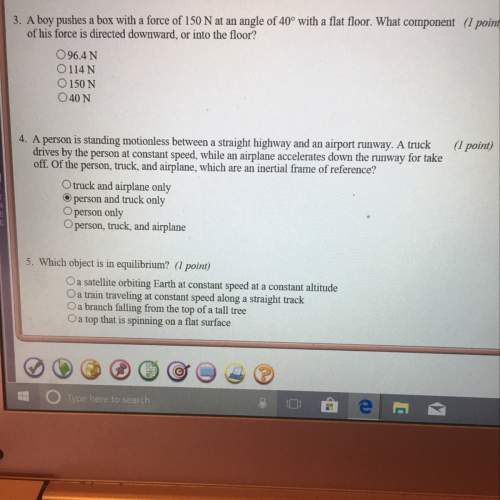

Answers: 1
Another question on Physics

Physics, 22.06.2019 00:20
Consider the particle-in-a-box problem in 1d. a particle with mass m is confined to move freely between two hard walls situated at x = 0 and x = l. the potential energy function is given as (a) describe the boundary conditions that must be satisfied by the wavefunctions ψ(x) (such as energy eigenfunctions). (b) solve the schr¨odinger’s equation and by using the boundary conditions of part (a) find all energy eigenfunctions, ψn(x), and the corresponding energies, en. (c) what are the allowed values of the quantum number n above? how did you decide on that? (d) what is the de broglie wavelength for the ground state? (e) sketch a plot of the lowest 3 levels’ wavefunctions (ψn(x) vs x). don’t forget to mark the positions of the walls on the graphs. (f) in a transition between the energy levels above, which transition produces the longest wavelength λ for the emitted photon? what is the corresponding wavele
Answers: 1

Physics, 22.06.2019 04:00
Ametal ball with a mass of 0.028 kg is dropped from rest at a height of 1.0 meters above the ground. assuming the energy in the ball is conserved, how much kinetic energy will the ball have when it is 0.5 meters above the ground?
Answers: 1

Physics, 22.06.2019 08:40
An isolated conducting spherical shell carries a positive charge. part a which statement (or statements) about the electric field and the electric potential inside and outside the spherical shell is correct? which statement (or statements) about the electric field and the electric potential inside and outside the spherical shell is correct? electric potential inside the shell is constant and outside the shell is changing as 1/r2 both the electric potential and the electric field does change with r inside and outside the spherical shell electric potential inside and outside the shell is constant, but not zero electric potential inside the shell is constant and outside the shell is equal to zero electric field inside and outside the shell is constant (does not change with the position r), but is not equal to zero electric field inside and outside the shell is changing as 1/r (where r is the distance from the center of the sphere) electric field inside is equal to zero and outside the shell is constant, but not zero electric potential inside the shell is constant and outside the shell is changing as 1/r electric field inside and outside the shell is changing as 1/r2 electric field inside is equal to zero and outside the shell is changing as 1/r2 electric field inside and outside the shell is zero electric field inside is constant and outside the shell is changing as 1/r
Answers: 3

Physics, 22.06.2019 11:30
Water is siphoned from a large tank and discharges into the atmosphere through a 50-mm diameter tube. the end of the tube is b = 2.1 m below the tank bottom which is a = 7.4 m deep, and viscous effects are negligible. determine the maximum height h over which the water can be siphoned without cavitation occurring. atmospheric pressure is 101.4 kpa, and the water vapor pressure is 1.79 kpa (absolute)
Answers: 3
You know the right answer?
The speed of light in a vacuum is 2.998 x 108 m/s. what is its speed in km/h?...
Questions



History, 21.11.2019 20:31



English, 21.11.2019 20:31

History, 21.11.2019 20:31

Mathematics, 21.11.2019 20:31


Mathematics, 21.11.2019 20:31


Biology, 21.11.2019 20:31




Spanish, 21.11.2019 20:31

Biology, 21.11.2019 20:31

Mathematics, 21.11.2019 20:31





